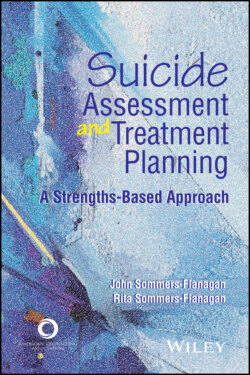Читать книгу Suicide Assessment and Treatment Planning - John Sommers-Flanagan - Страница 45
Competency 3: Know and Elicit Evidence-Based Risk and Protective Factors
ОглавлениеCramer and colleagues (2013) wrote, “One of the clinician’s primary objectives in conducting a suicide risk assessment is to elicit risk and protective factors from the client” (p. 6). As we discuss in greater detail later, this competency is problematic for at least three reasons. First, in an extensive meta-analysis covering 50 years of research, the authors concluded, “All risk (and protective factors) [for suicidal thoughts and behavior] are weak and inaccurate. This general pattern has not changed over the past 50 years” (Franklin et al., 2017, p. 217). In other words, there is no clear formula of risk and protective factors that accurately predict suicide.
Second, the number of potential risk and protective factors of which counselors should be aware is overwhelming. Granello (2010b) reported 75-plus factors, we have a list of 25 (J. Sommers-Flanagan & Sommers-Flanagan, 2017), and even Cramer and colleagues (2013) lamented, “It would be impossible for clinicians to be familiar with every risk factor” (p. 6). Jobes (2016) referred to suicidology as “a field that has been remarkably obsessed with delineating countless suicide ‘risk factors’ (that do little for clinically understanding acute risk)” (p. 17).
Third, prominent suicide researchers have concluded that efforts to categorize client risk are ill advised (McHugh et al., 2019; Nielssen et al., 2017). For example, even the most commonly identified symptom of suicide, suicidal ideation, is a poor predictor of suicide in clinical settings; this is because suicidal ideation occurs at a very high frequency, but death by suicide occurs at a very low frequency. In one study, 80% of patients who died by suicide denied having suicidal thoughts when asked directly by a general medical practitioner (McHugh et al., 2019). Even the oft-cited risk factor of a previous suicide attempt has only a small statistical relationship to death by suicide. In a review of 17 studies examining 64 unique suicide prediction models, Belsher and colleagues (2019) reported, “These models would result in high false-positive rates and considerable false-negative rates if implemented in isolation” (p. 642).
To summarize, this suicide competency includes a deep dialectic. Clinicians absolutely must be aware of suicide risk factors, warning signs, and protective factors. Granello (2010b) recommended that counselors keep a list of relevant risk factors and warning signs on their desks. However, as Belsher et al. (2019) noted, risk and protective factors and warning signs—or any checklist or instrument—should not be used in isolation; an overemphasis on checklists impedes development of the therapeutic relationship, and the statistical reality is that suicide is not predictable and risk categorization is typically inaccurate. This competency can be boiled down to four parts, some of which form a dialectic:
1 Competent practitioners should have knowledge of evidence-based suicide risk and protective factors.
2 Competent practitioners are aware that evidence-based suicide risk and protective factors may not confer useful information during a clinical interview.
3 Instead of relying on checklists of suicide risk and protective factors, competent practitioners collaboratively identify and explore client distress and then track client distress back to individualized factors that increase risk and enhance protection.
4 Competent practitioners use skills to collaboratively develop safety plans that address each client’s unique risk and protective profile.
Although risk and protective factors do not provide an equation that tells clinicians what to do, knowing and addressing each unique individual’s particular risks and strengths remains an important competency (Granello, 2010b).
